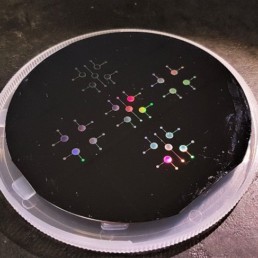
Plasmonic Biosensors and Microfluidics
The LaNN laboratory is one of the most important nanofabrication centers in Italy and it’s active in several research fields.
A phase-interrogation setup based on polarization scan has been successfully implemented, allowing a high integration and miniaturization of the plasmonic sensor in lab-on-a-chip platforms. The detection setup (patented) is simple, cost effective and guarantees high sensing speeds and performances.
Lab-on-a-chip fabrication is made possible exploiting a combination of different nanometric and micrometric fabrication techniques. One-dimensional gold gratings, sinusoidal or digital, have been made by laser interference lithography combined with thermal evaporation of gold. The gratings can be integrated in microfluidic circuits using optical lithography and soft lithography both in PDMS and OSTE. This allows real-time sensing in aqueous biological environments, while using small volumes in the order of 1μL or even less. The induction of a swirling flow inside the microfluidic cells, with the addition of surface acoustic wave (SAW) circuit in a lithium niobite substrate, was proved to drastically reduce functionalization and biorecognition times compared to static or laminar flow.
One of the most promising use for grating couplers in bio-sensing is the fabrication of microarrays, making possible various independent measurements at the same time. Multiplexing for one-time multiple measurements is obtained with optical lithography combined with wet or dry etching, allowing to divide each plasmonic spot in numerous micrometric squares. The combination with azimuthally-rotated gratings and microfluidics gives a powerful tool for lab-on-a -chip analysis for the screening of biomarkers.
LaNN can count on a number of highly qualified researchers whose experience ranges from the synthesis of materials, to manufacturing and characterization, to biological and biochemical functionalization.

Contacts
Filippo Romanato: filippo.romanato@unipd.it
